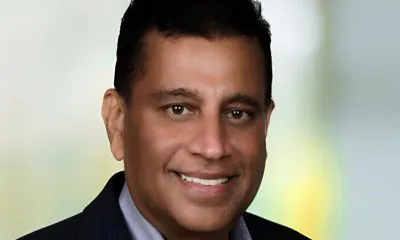Interviews
Sebastian Enderlein, Chief Technology Office at DeepL – Interview Series

Sebastian Enderlein, Chief Technology Officer at DeepL, is a European-born technologist with over a decade of experience in Silicon Valley, where he held senior engineering leadership roles at companies like Uber, Salesforce, and Personio. With a strong background in cloud infrastructure, distributed systems, and building high-performing engineering organizations, he has helped scale some of the fastest-growing tech companies in both the U.S. and Europe. Today, he splits his time between San Francisco and Europe, serving as CTO at DeepL while also advising and investing in startups, with a focus on solving complex technical challenges and helping scale-ups on their path to becoming unicorns.
DeepL, launched in 2017, is a neural machine translation service recognized for delivering highly accurate and natural-sounding translations across more than 30 languages. Using advanced neural networks and proprietary AI enhancements, it consistently outperforms competitors in fluency and precision. Available via web, desktop and mobile apps, browser extensions, and API, DeepL also offers a Pro version with enterprise-grade features, unlimited usage, and enhanced security.
You’ve spent time building engineering teams on both sides of the Atlantic—Silicon Valley and Europe. What personal lessons have shaped your approach to leadership and innovation across these very different tech ecosystems?
Both ecosystems have their unique strengths and characteristics and I’m grateful to have gained deep insight and experience in both cultures. In Silicon Valley, there’s this really exciting startup culture with highly motivated, globally diverse engineers chasing big ideas, backed by a mindset that moves fast and embraces bold risks. There’s also a lot of pressure, and the pace can be intense – companies often have ambitious visions, scale rapidly and either succeed or fail quickly. My time there taught me a lot about scaling teams and technology fast, and about how to balance ambition with the pressures that pace can bring.
In Europe, there’s also strong talent, ideas and innovation with teams that are often multilingual and multicultural, and there’s a clear emphasis on security, compliance and precision. The continent’s diversity can be a strength, bringing rich perspectives, but also a challenge with fragmented markets, varying legal systems and higher demand for compliance. I’ve also noticed startups there are more likely to self-fund, which can sometimes slow growth but also builds resilience and long-term staying power. For DeepL, having our roots in Europe has been a clear strength. It has shaped our focus on precision, security and cultural nuance, helping set us apart as a leader in the fast-paced AI landscape.
What motivated you to join DeepL as CTO after your time at Personio and your experience with companies like Uber and Salesforce?
When I first met Jarek, DeepL's CEO and founder, along with the rest of the leadership team, I was immediately drawn to their clarity of vision and passion for solving a truly meaningful problem with AI. DeepL isn't just building cool AI tech for the sake of innovation. They're laser-focused on building products that solve real, everyday problems for people and businesses – and they’re passionate about it. That sense of purpose and potential, and the company’s culture which is so deeply rooted in practical innovation and real-world impact, was a major motivator for me and made me excited to join the team. I’ve seen the impact of mission-driven teams during my time at Personio, Uber, and Salesforce.
As someone who spends a lot of time on both sides of the Atlantic, the company’s mission to break down language barriers also stood out to me. DeepL is solving a very real challenge faced by people and businesses everywhere; one that I’ve both experienced personally and also seen firsthand. Whether it’s global teams trying to collaborate more effectively or companies looking to grow into new markets, language barriers can slow everything down. So I was also excited by the opportunity to join the team and help tackle that challenge in a meaningful way.
Let’s talk about Clarify. It’s not just a translator—it’s interactive, contextual, and adaptive. What was the initial spark for developing it, and how does it push the boundary of what language AI can do?
A big focus for us this year has been looking at how we can enhance the products we offer through our Language AI platform – from DeepL Translator, to our real-time voice translation solution, Deepl Voice – so that they can become even more personalized, collaborative and intuitive. We want the DeepL experience to feel less like traditional software and more like working with a smart collaborator and that’s exactly what Clarify delivers.
Languages are incredibly nuanced. Words and sentences can have multiple meanings, cultural implications or grammatical variations, like gendered nouns or idioms that don’t translate cleanly. Clarify, which is available via the DeepL Translator, was built to help our customers navigate those complexities, acting as an interactive AI language expert that engages directly with users to resolve ambiguity and surface deeper context. For example, Clarify will help determine if “bank” in a sentence might refer to a river or a financial institution, or translating “the professor” without knowing the gender.
What’s exciting about Clarify is it transforms the DeepL translation process from a one-way input-output model into a true collaboration. Rather than passively receiving results, users interact with Clarify throughout the process. The tool will proactively suggest edits and suggestions, so that you arrive at the most accurate outcome together.
One of the most fascinating elements of Clarify is its ability to detect ambiguity and prompt users for clarification. How do you technically define “ambiguity” in a way that a machine can recognize and act on?
It’s a great question – ambiguity is a known challenge in machine translation, but is often overlooked or sidestepped because understanding a user's intent in real time can be challenging. However, ambiguity can completely change the meaning of a translation depending on how you understand the input. To address this, our researchers collaborated closely with language experts to identify instances where this happens and develop systems that can respond accordingly.
DeepL has a reputation for precision, but now it’s moving into personalization and collaboration. How do you balance model performance with UX to ensure the AI doesn’t just give “a” translation—but the right one for that user?
Like you are saying, the “right” translation isn’t always universal. It depends on context, language pair and use case. One company may require specific internal terminology, while another may need to capture a particular tone or nuance. For us, precision and personalization aren’t separate goals, but rather work together to ensure quality.
At DeepL, when we think about quality we’re focused on providing translations and outputs that are technically accurate and contextually appropriate, but that are also aligned with the user’s intent. Our Language AI platform reflects this – we’re combining cutting-edge model performance with smart UX to ensure our customers receive translation outputs that truly fit their needs.
Many general-purpose models fall short when it comes to language nuance and cultural context. What makes DeepL’s models different, and why is specialization such a critical advantage?
The models that power our Language AI platform are purpose-built for translation and writing. This focus gives us a significant advantage in capturing nuances, contexts, and tones across languages, which is critical in business settings where precision is paramount.
Unlike general models trained on broad internet data, DeepL’s proprietary LLMs are trained on 7+ years of domain-specific content and undergo additional fine-tuning by thousands of professional linguists. This specialization enables us to consistently deliver higher quality and reliability. In blind tests in 2024, professional translators found that our next-generation LLM required 2-3x fewer edits than Google or ChatGPT to achieve the same quality. That’s why more than 200,000 business customers worldwide trust DeepL. In fields like law, tech, healthcare, and marketing, even small mistranslations can have serious consequences. Quality and accuracy aren’t optional.
From your time managing cloud infrastructure at Uber to leading engineering at Personio and now DeepL, what’s been the hardest engineering challenge you’ve faced—and what did you learn from it?
From a people perspective, the hardest challenge has been leading teams through long phases of hypergrowth, finding the right balance between moving fast and staying efficient and also ensuring new hires are onboarded well, understand the company’s mission and have opportunities to grow. One big lesson I learned there was to avoid the pendulum swing between extremes. Shifting rapidly from “growth at all costs” to “high efficiency” is hard on an organization, and more than doubling a tech team in a year inevitably creates strain – I’ve since set that as a rough upper limit.
From a technology perspective, I’ve spent much of my career scaling tech stacks in the cloud and around the world, dealing with complex problems around consistency and reliability for some of the most popular services on the planet. I’ve learned that over-architecting is a serious issue, and “over-platforming” can cripple your organization and make accountability for customer impact harder to achieve. With AI accelerating the pace of business even more – companies can now reach $100M ARR in under a year, and teams are seeing unprecedented productivity gains – focus and simplicity are more important than ever.
DeepL now serves over 200,000 businesses and government institutions. How do you maintain the balance between enterprise reliability and innovation at speed?
It’s a balance we think about all the time. Our business customers rely on DeepL for critical high-stakes communication, so reliability, security and trust are really essential. At the same time, we know that innovation can’t slow down… the AI industry is moving at lightning speed! The key is, in some ways, is focus. When it comes to our Language AI platform, we're focused on solving complex language problems with high accuracy and precision. This focus enables us to move quickly without compromising quality.
We’re also highly adaptable. We can introduce new capabilities or features, delivering forward-looking solutions that push the industry ahead, while also maintaining the enterprise-grade quality, accuracy and performance that our customers know us for and continue to expect. A great example of this is the recent expansion of DeepL Voice: we just announced that it now offers support for spoken input from Mandarin Chinese, Ukrainian, and Romanian, along with enhanced meeting productivity features and a major upcoming integration with Zoom Meetings, which is really exciting.
Finally, what do you believe the future holds for language AI?
Language AI is already transforming how we, as businesses, employees and people, communicate globally, enabling deeper connection and collaboration across business, cultures, and industries. We’re moving toward a future where companies of all sizes can operate and grow internationally without being held back by language barriers, opening the door to a more connected, inclusive world and economy.
Thank you for the great interview, readers who wish to learn more should visit Deepl.












